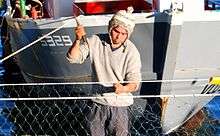Net (device)

A net, in its primary meaning, comprises fibers woven in a grid-like structure. It blocks the passage of large items, while letting small items and fluids pass. It requires less material than something sheet-like, and provides a degree of transparency.
The adjectives reticulated and retiary both mean "net-like". Animal species such as the reticulated giraffe and reticulated python have net-like body markings.
Most of the other meanings of the term arise by analogy with the use above, see net.
History

The oldest nets found are from the Mesolithic era, but nets may have existed in the Upper paleolithic era.[1]
Nets are typically made of perishable materials and leave little archeological record. Some nets are preserved in ice or bogs, and there are also clay impressions of nets.
Making and repairing nets


.jpg)
This section does not cover meshes made of open-weave fabrics, only knotted and twisted nets.
Nets were formerly all made by hand. They can be started from a single point, for round nets (such as purse nets, net bags, or hair nets), but square nets are usually started from a headrope.[3] A line is tied to the headrope at regular intervals, forming a series of loops. This can be done using slipped overhand knots, as in the image above, or using other knots, such as clove hitches. Subsequent rows are then worked using sheet bends, as shown, or another knot (some nets, such as hammocks, may even be looped rather than knotted).
To avoid hauling a long length of loose twine through each knot, the twine is wound up on a netting shuttle or netting needle. This must be done correctly to prevent twisting as it is used,[3] but makes net production much faster. A gauge (a smooth stick) is used to keep the loops the same size and the mesh even. The first and last rows are generally done with a half-size gauge, so that the edges of the net will be smooth.
Nets can now be knotted by machine, and there are also knot-free nets. However, mending nets by hand is still an important skill for those who work with them. Some nets are also still shaped by their end users.[4]
When a hole is ripped in a net, there are fewer holes in it than before the net was ripped. However, the stress concentration at the edges of the hole will frequently cause it to tear further, making timely repairs important.
Materials
Nets may be made using almost any sort of fiber. Traditional net materials vary with what was locally available; for instance, early European fishing nets were often made of linen, although longer-lasting synthetics are now fairly universal. Nylon monofilament nets are transparent, and are therefore often used for fishing and trapping.
Structural properties

Nets, like fabric, will stretch less along their constituent strands (the "bars" between knots) than diagonally across the mesh holes. They are, so to speak, made on the bias.
The materials used also affect the structural properties of the net. For instance, safety nets must deaccelerate the person hitting them gradually, usually by having a concave-upwards stress–strain curve (the amount of force required to stretch the net by a given amount increases the further the net is stretched).
Uses
Transport
Examples include cargo nets and net bags. Some vegetables, like onions, are often shipped in nets.
Sports
Nets are used in sporting goals and in games such as soccer, basketball, Bossaball and ice hockey. A net also separates opponents in various net sports such as volleyball, tennis, badminton, and table tennis, where the ball or shuttlecock must go over the net to remain in play.
Capturing animals
Nets for capturing animals include fishing nets, butterfly nets, cricket nets, bird netting, and trapping nets such as purse and long nets. Some, like mist nets, rocket nets, and netguns, are designed not to harm the animals caught. Camouflage nets may also be used.
Furnishings
Hammocks, safety nets, and mosquito nets are net-based. Some furniture includes a net stretched between the sides of the frame. Multihull boats may have net trampolines strung between their hulls.
Clothing
See also Net (textile)
Hair nets, net lace, and net embroidery are sartorial nets.
Armed conflict
Anti-submarine nets and anti-torpedo nets can be laid by net-laying ships.
References
- ↑ Martin Trachsel (2008) (in German), Ur- und Frühgeschichte: Quellen, Methoden, Ziele, UTB, p. 56, ISBN 3-8252-8369-0
- ↑ "Fishing nets for a future: helping Syrian women in Lebanon". webarchive.nationalarchives.gov.uk. Archived from the original on 2013-06-03. Retrieved 2015-04-08.
- 1 2 Netting instructions
- ↑ Net making (and repair) guide for commercial fishing nets.
| Look up net in Wiktionary, the free dictionary. |